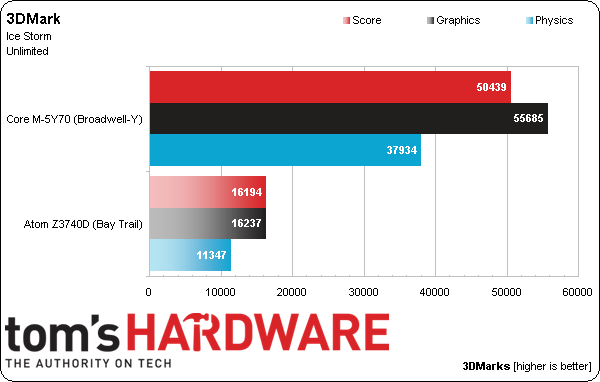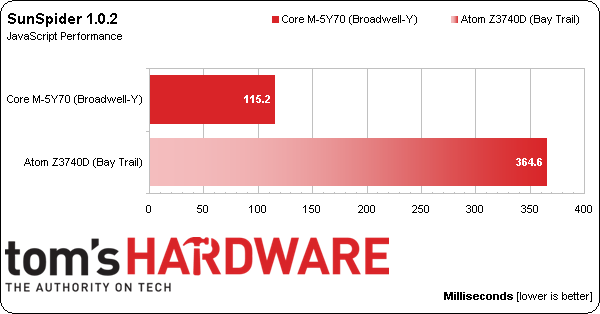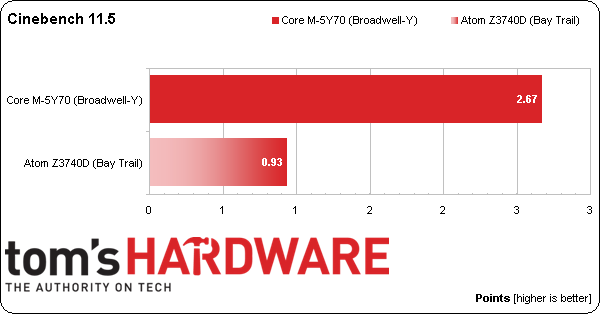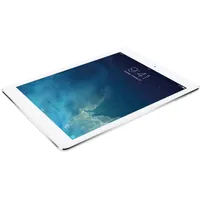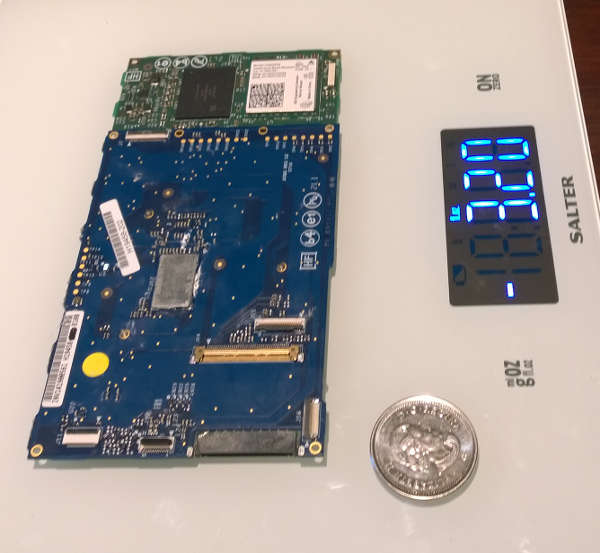Intel's Broadwell Core M-5Y70: The First Benchmarks
Straight from IDF, we're pleased to bring you the first comparison benchmark results from the Broadwell-based Core M-5Y70!
Intel brought us by to run some benchmarks on the company's upcoming low-power Core M processor. We saw what the Core M-5Y70 (Broadwell-Y, 4.5W TDP) can do in a fanless tablet enclosure, and we compared it to an Atom Z3740D (Bay Trail, <4W TDP). Without further ado, lets get straight to those results:
The 3DMark scores demonstrate about a 3x performance increase for the Core M-5Y70. The interesting part is that this bump isn't restricted to graphics performance, but shows up in CPU physics computations, too.
Both SunSpider and Cinebench also showcase the Core M's strengths, with about a 2.5x advantage for the new low power Broadwell CPU compared to Bay Trail.
You might be thinking that it isn't fair to compare a Core M (Broadwell-Y) to an Atom (Bay Trail). From a pricing perspective you'd be right: the Core M processor alone costs in the $300 range, while an entire tablet powered by an Atom processor, such as the Dell Venue 8 Pro, can be purchased for that price. Expect to pay closer to $1,000 for a premium Core M tablet or convertible. In addition, Bay Trail platforms are limited to 2 GB of RAM, while the Core M we benchmarked is equipped with 4 GB, so there's a good chance that is also a factor in the test results.
But the comparison becomes relevant from a functionality standpoint: if you want a fanless x86 Windows tablet under 8 mm thick, Haswell-Y isn't a competitor. Bay Trail-based Atom processors were the best you could get before Core M arrived on the scene, and the difference in performance that Broadwell-Y brings for very thin and light tablets is monumental. Apple's iPad was the top-tier performer in this class, but it seems a foregone conclusion that Core M is going to change that situation in a hurry.
Speaking of the iPad, the Llama Mountain prototype tablet Intel showed us sports a 12.5" screen and weighs a mere 685 grams, with a slightly larger screen but practically the same weight as the product from Cupertino.
Intel had three demo models for us to check out: one with an aluminum chassis, one in gold-plated aluminum, and one in copper. These were used to test Core M's ability to stay within its thermal envelope, and the company claims that the new Broadwell-Y processors are able to keep suitably cool within all of these enclosures. It didn't make a difference in their performance tests.
Get Tom's Hardware's best news and in-depth reviews, straight to your inbox.
Speaking of heat generation, Intel mentioned that OEMs have the option to configure all Core M processors to one of three TDP targets: 3 Watts, 4.5 Watts, or 6 Watts. This is to allow manufacturers to cater products for specific use-case scenarios. For instance, the top of the line Core M 5Y70 could be limited to a 3 Watt TDP in a product designed for maximum battery life. On the other hand, an enclosure with active cooling might support a 6 Watt TDP and provide a snappier response (to clarify, a 6 Watt solution wouldn't necessarily require a fan, a thicker enclosure with better heat dissipation would also do the trick).
While more options are always nice to have, we have to note that consumers will have to be aware that the processor model number alone no longer guarantees a set level of performance. A Core M-5Y70 configured for a 3 Watt TDP will certainly demonstrate lower performance than the same processor with a 6 Watt TDP. Furthermore, a low-end Core M-5Y10 configured with a 6 Watt TDP would almost certainly outperform the top-of-the-line Core M-5Y70 configured for 3 Watts.
Intel strongly suggested that OEMs would probably apply TDPs to processors in a manner that makes sense from a marketing point of view. That's probably true but the point is that, now more than ever before, specific tablet and convertible models may perform better or worse based on the manufacturer's decision rather than just the processor they've been outfitted with. We might see meaningful differences between two products that carry the same model of CPU.
The picture above shows how small the Llama Mountain platform really is. Even with the daughterboard attached, as demonstrated it's a surprisingly small combo of PCBs, weighing in slightly over 3.2 ounces.
Aside from the benchmark numbers, we were shown some real-world demonstrations of the performance delta between two fanless convertibles. One was Lenovo's recently announced Helix tablet outfitted with a Core M-5Y10 (attached to the monitor on the right), versus a tablet armed with the Atom Z3740 (on the left monitor).
Unsurprisingly, the experience mirrors the benchmark results as there is a notable performance delta between the Atom and Core M. We look forward to testing Intel's new low-power darling against 11.5 Watt Haswell-Y CPUs to see if it can keep up or even surpass its predecessor with more than twice the TDP.
In addition, we were shown a real-world demonstration of Intel Moorefield powered tablets. Moorefield is a platform for Intel's Atom configured for use with the Android operating system. Here is a visual demonstration of the real-world performance difference between the quad-core Moorefield system (on the left) an 8-core ARM A9 Cortex (on the right):
Intel purports that the reason their quad-core Atom can show up the 8-core A9 is Intel's advantage when it comes to instructions-per-clock, coupled with the way Android is somewhat limited when it comes to efficient multi-threading.
Note that the Moorefield tablet is Dell's Venue 8 7000, the tablet that was just announced at IDF and equipped with Intel's RealSense dual camera system. Thanks to this hardware, Dell's tablet is capable of surprising functionality such as measuring objects from pictures. All of the Venue 8 7000's capabilities are not yet fully known, but a dual camera system is theoretically capable of taking 3D pictures, too.
Follow us @tomshardware, on Facebook and on Google+.
Don Woligroski was a former senior hardware editor for Tom's Hardware. He has covered a wide range of PC hardware topics, including CPUs, GPUs, system building, and emerging technologies.
-
abitoms @DonReply
You said: "Bay Trail-based Atom processors were the best you could get before Core M arrived on the scene". On what factors is this proposition based? -
Because0789 Reply@Don
You said: "Bay Trail-based Atom processors were the best you could get before Core M arrived on the scene". On what factors is this proposition based?
Fanless I believe -
BlasterX Wait, 300$?Reply
If this is true, then Intel lost my hope on the Core M platform. Then you would rather want a Core i7 than a processor only as fast as the Pentium. -
icemunk How nice speeds, but hitting the retail at $300 is just overkill. If Intel wants to dominate mobile, it needs to quickly get the cost down so we can have cheap Core M tablets.Reply -
SuperVeloce ReplyWait, 300$?
Now show me a snappy fanless i7 tablet. Oh noes, there isn't any?
If this is true, then Intel lost my hope on the Core M platform. Then you would rather want a Core i7 than a processor only as fast as the Pentium. -
neblogai I don't care if Core M allows fanless tablets. A $281 processor that is released to change previous $281 tablet processor (i5) should be benchmarked with it, not with some Atom.Reply -
SuperVeloce No, you first test something with the same usecase and only then you stack those results by price. Fanless is the mayor factor here.Reply
If you want $200 tablet, you can have arm/atom one. If you need more power, there is a price to pay, just like buying a top mobile phone for $600. -
neblogai So I want the same usecase- which is a form factor of surface pro 2 or 3. I'm happy with the size, weight and battery life. Core M, if used in next surface pro, would be a downgrade in processor speed - while still being just as expensive. That is why I want benchmarks - to compare how much slower it is.Reply -
frozentundra123456 Yea, I am not sure it is a good idea to make your lower priced cpu look so anemic. Atom in both x86 and android is what Intel needs to really make headway against ARM in tablet/phone space. Seems like Intel is slipping back into the attitude that got them into trouble in the first place, that is focusing too much on high end, high margin devices and neglecting atom. Even if it is a great product, I see Core M more taking market share from Intel's own laptop/ultrabook/convertible sales than making headway against Android/IoS.Reply -
swordrage So I'm not the only one who thinks that fan-less-ness is not so important for a productivity tablet.Reply
Yes, it is impressive if you can do that, but I'd rather have a standard U series or even M series (the previous M) processor just to have that extra performance. I will definitely go for it if a fanless tablet can perform as well as one with a haswell U series processor. I think and hope the next gen core M will be hitting that performance level. I am really happy about the increase in GPU performance though.
